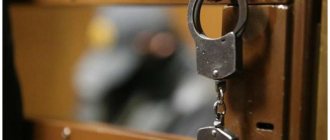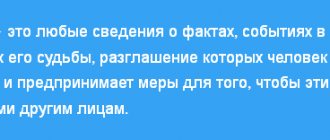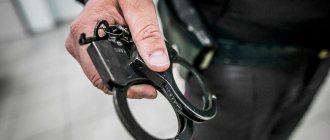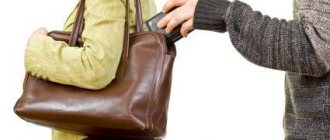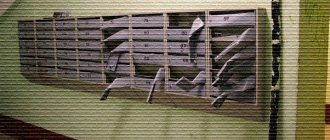Inspection of traces of a crime and other discovered objects is carried out at the place of investigative action. Purpose of home inspection
- identify traces and objects, as well as their features indicating the method of penetration. A home inspection is carried out in the following cases (Article 177 of the Code of Criminal Procedure of the Russian Federation):
- the inspection of the home was carried out with the consent of the persons living in the inspected home;
- the inspection of the home was carried out on the basis of a court decision;
- inspection of the home is possible in the situation provided for in Part 5 of Art. 165 Code of Criminal Procedure.
The nature and location of traces left by the criminal at the crime scene located in the home depend on the method of entry into the premises
. Therefore, the inspection of the crime scene in such cases, as a rule, begins with clarifying the specified circumstance.
The most common methods of entering a home include the following.
Who needs it
The inspection is carried out to determine how well the information you provide and the declared indicators correspond to the real state of affairs.
For example, tax authorities want to make sure that the office is operational, warehouse or production facilities are available. That the premises were actually repaired, which you recognized as expenses and for which you claimed VAT reimbursement. Or that the area of the sales floor actually corresponds to the value reflected in the declaration/calculation for UTII and does not exceed the permissible values.
And of course, they come for an inspection to see if you are doing something that would be extremely fiscally interesting. Maybe some kind of stamps, blank forms from other people's offices, people not working in the company, strange companies or other suspicious fabrications. Suddenly something catches your eye, or careless employees blurt something out.
Tax officers often come for inspection accompanied by police officers. For what? To keep you in good shape. The methods are stricter, the requirements are louder and more specific. An inspection as part of operational investigative activities (OPM) is not a tax trick.
We behave very carefully. No fuss. No aggression. Definitely without fear. Nothing like this has happened yet - they are inspecting and looking for something. But if your business is clean, and you know how to behave and are ready not to obey, but to act, you should not be afraid of negative results. Therefore, after the natural slight excitement of a sudden visit, calm down, collect yourself, and tune in to a business-like tone. And start working with auditors, trying to manage the situation and keep all actions under control.
Basic goals
Inspections are carried out to (clause 4.1):
- quantify the parameters that characterize the standard or operational technical condition of the property;
- promptly identify discrepancies between the condition of the property and the design indicators and the requirements of the legislation of the Russian Federation;
- promptly identify threats to the safety of life and health of citizens and the environment;
- determine the scope of work, formulate and adjust the plan and list of work performed during property maintenance, etc.
About access: who and when
The procedure for tax officials to access the territory or premises to conduct a tax audit is regulated by Article 91 of the Tax Code.
When is it legal:
1. Only officials of the tax authority who directly conduct a tax audit have access. That is, not any inspection employee, but only those who are authorized to carry out inspection activities and are indicated in the relevant administrative document.
2.Visitors are required to present official identification and:
- decision of the head of the tax authority - in case of an on-site tax audit or
— a reasoned decision to conduct an inspection as part of a desk audit. The resolution is drawn up and signed by the inspector conducting the desk audit and approved by the head of the tax inspectorate.
Therefore, the first thing you should do is check all the documents and credentials of the inspectors who visited the company. Persons not specified in the documents do not have the right to be on your territory and cannot inspect territories, premises, documents and objects. You can categorically protest and not let them in.
About access to residential premises
Access to the residential premises of tax officials conducting tax audits is only possible
1) with the consent of the persons residing therein or
2) by court decision or in cases specifically prescribed by law. A tax audit does not apply to these special cases.
It is interesting that if a remote server with a company database is installed in the apartment of an IT employee, and the accounting records are stored in the director’s house, it is impossible to get to them without initiating a criminal case.
Inspection of the residential premises of an individual entrepreneur or an ordinary citizen as part of a tax audit is also possible only with the consent of the persons living in them.
When can an inspection be carried out?
As part of an on-site tax audit
1. During an on-site inspection, the inspectors specified in the decision to order an on-site inspection have the right to conduct an inspection of premises, territories, documents and objects without any restrictions. No additional regulations are required to carry out the inspection.
2. The inspection cannot be carried out outside the on-site inspection, including during its suspension. And during additional events.
3. In practice, the inspection of territories and premises during an on-site inspection, as a rule, is of little evidence: the result of the inspection at the time of the inspection - after a long time (during the inspection period of 2-3 years) after the fact of the alleged violation by the tax authorities - can be effectively challenged in court.
4. Inspection of documents and objects is a completely different matter. Be careful! If, during the inspection, suspicious circumstances are revealed about controlled companies, gray schemes, and one-day transactions, the inspection report will be presented to the court as evidence of tax offenses.
5. During on-site inspections, an inspection is always carried out. It's worth preparing. Tips in the article If you have arrived, how to prepare for a tax audit.
As part of a desk audit
1. During a desk inspection, inspection is legal in strictly defined cases:
- if the declaration states the amount of VAT to be refunded,
- if the declaration reveals contradictions or inconsistencies indicating an understatement of the amount of VAT payable or an overstatement of the amount of tax to be reimbursed.
2. As part of a desk audit, tax officials come to the inspection with a reasoned resolution from the inspector who is conducting the desk audit, approved by the head (or deputy head) of the inspection.
Outside the scope of inspections
1. The Tax Code allows inspection outside the scope of inspections only in relation to documents and objects. And moreover, only previously received by tax authorities (on tax control actions taken), or in case of consent of the owner of these items (clause 2 of Article 92 of the Tax Code of the Russian Federation).
2. For real estate objects, the right to inspection outside the scope of inspections is permitted by Article 9 of the Law of 08.08.2001 N 129-FZ “On State Registration of Legal Entities and Individual Entrepreneurs”. Inspection is used both during counter inspections and when submitting an application to the tax authority to carry out registration actions.
3. The judicial authorities are not against inspection outside the framework of inspection activities - they are on the side of the tax authorities. They interpret the norms of tax law in their own way: there is no direct ban on conducting inspections of premises outside the framework of inspections in tax legislation. This means they can come and inspect.
Features of inspecting the scene of an incident in individual houses
Inspection of the area adjacent to the house
When inspecting the area adjacent to the house
Footprints of shoes (footprints) can be found on soft ground, which can be used to judge:
- number of criminals
- the height of the criminal
- gait features,
- routes of approach and departure,
- type and size of shoes, their individual characteristics.
It is possible to detect stolen items, their packaging, burglary tools and tools
left by criminals.
By tracing the trail of footprints, you can establish:
- sequence of actions of the criminal,
- determine the place from where he was monitoring the house: there may be food remains, bottles, cigarette butts, burnt matches, scraps of newspapers and wrapping paper, and other objects.
If the criminals used a car
, you can find:
- tire tread marks and their features,
- set the base, track, car model and determine the direction of its movement.
When inspecting the territory, you should pay attention to the places where the criminal overcame the fence
:
- torn, broken boards,
- wire mesh snacks,
- Undermining.
In these places there may be traces of hands, tools, scraps, threads and fibers of clothing, and other objects.
If the criminal used a ladder
, then near places through which one can enter the house (windows, attic, etc.), traces in the form of dents and scratches may be found on the ground and wall of the house. Traces of hands, burglary tools and tools, clothing fibers, hair can be found on the glass and frames of windows, vents, transoms, and traces of shoes can be found in the attic. Traces of dust, attic backfill, paint used to paint the house, and other substances may remain on the criminal’s clothes and shoes.
Traces characterizing the actions of the criminal inside the home
Having entered the house, the criminal opens or breaks down the doors, leaving traces of hands, gloves, shoes, and burglary tools.
Typically, the criminal focuses on the typical situation of an ordinary family and looks for money in places such as:
- in the closet,
- desk,
- ladies' handbags,
- linen or along with other valuables on bookshelves,
- in the secretary,
- boxes.
In this case, the search is accompanied by throwing things out of closets, rearranging or damaging objects, i.e. this situation indicates an inappropriate search.
If the above signs of an inappropriate search are absent, the criminal was looking for hiding places or took only certain items (money, electronics, jewelry), this indicates a certain awareness of the criminal about the financial situation of the victim and the target direction of the search.
Sometimes the character of the kidnapped person can be used to judge certain traits of the criminal.
: For example:
- the addict can take the appropriate medicine,
- teenager - souvenirs, toys, CDs, leaving more valuable things unattended;
- the collector will show interest in stamps, awards, etc.
When inspecting a home and searching for traces of a criminal, you should pay attention to the following points:
- opening doors, moving objects, the criminal leaves his traces on them: individual smell, traces of hands or gloves, hair, clothing fibers;
- when eating food at the scene of the incident, traces of teeth may be found on its remains;
- when performing natural needs - traces of urine and feces;
- when smoking - cigarette butts, ashes, burnt matches, cigarette packages, from which conclusions can be drawn about the stable habits of a smoking person.
What can they inspect?
All: no restrictions regarding specific objects of inspection are provided by the current legislation.
Tax officials can inspect any documents and items that, in their opinion, are important for verifying the accuracy of the tax base when calculating any taxes.
Explore office, industrial, warehouse, retail and other premises and territories used by the company in its activities.
Everything on the company premises is a potential source of evidence for tax authorities.
Results
Inspection of premises and territories allows tax authorities to obtain evidence of various tax offenses. It is carried out during a tax audit in the presence of witnesses and with the participation of specialists (if necessary). The person being inspected has the right to be present during the inspection, and the results of the inspection are documented in a protocol.
Sources:
- Tax Code of the Russian Federation
- Order of the Federal Tax Service of Russia dated November 7, 2018 N ММВ-7-2/ [email protected]
You can find more complete information on the topic in ConsultantPlus. Free trial access to the system for 2 days.
Acute questions during an inspection
Presence of a company representative at the inspection
The right to be present at the inspection is legal. (Clause 3 of Article 92 of the Tax Code). Exactly right.
The inspection can be carried out in the absence of a company representative. They invited two witnesses - and the event was legal.
You can then argue about loss of rights. But don’t rely too much on the court - if the tax authorities reveal violations, your statements about the invalidity of the inspection results due to the absence of a company representative are in vain.
Therefore, you always need to be aware of this, calculate the risks, take measures and be prepared for the sudden arrival of uninvited guests.
Witnesses are required
There must be at least two witnesses. If there are several inspectors and they are scattered around the office, ask for more witnesses: let two witnesses go with each one according to the rule: 1 inspector = 2 witnesses.
Tax authorities and other persons who are in any way interested in the outcome of the case cannot be witnesses.
The actions of witnesses must be carefully observed: where the witnesses are when any circumstances are identified. They took out stamps, a flash drive - from where - where the witnesses were, maybe in another room, looked in the other direction, ran into the room to confirm...
Record all miscalculations and oddities and include them in the inspection report.
Witnesses have the right to make comments regarding the actions taken. And these comments must be included in the inspection report.
Inspection reports drawn up in the absence of witnesses are flawed reports that judicial authorities do not recognize as evidence.
Video and photo recording
During inspections, tax officers may take photographs, films, videos, and make copies of documents. The fact of using technical means must be reflected in the protocol.
Photographs and videos, copies of documents and other materials obtained during the inspection must be attached to the protocol.
Advice: take pictures of everything too. You have the right. What if they don't let you film? Write everything down on paper. And also lift the ban on filming... If the actions of the tax authorities are legal, why ban them? Demonstrate confidence and determination to challenge misconduct.
You cannot film only operational-search activities. During a search (according to the Code of Criminal Procedure), recording has the right to be limited.
Photography and video recording of the presence of witnesses cannot replace it!
About attracting experts
For certain issues, specialists with special knowledge and skills may be invited for inspection, for example, in the field of estimating or construction.
It is important to know that specialists are engaged by the tax authority on a contractual basis. This agreement must be included in the tax audit materials. If there is no agreement, all the testimony of the specialist and his conclusions are very ambiguous evidence. They can be argued to be rejected and invalidated.
Inspection time
The question of the timing of the inspection is not regulated by tax law. As a general rule, all tax control activities are carried out during working hours, which are determined by the company’s internal labor regulations.
You should not expect to be able to challenge the results of an inspection extended beyond the established working hours. It is unlikely that the court will recognize the inadmissibility of using evidence obtained by the tax authority outside the work schedule.
Therefore, if the process is delayed or the tax authorities come in the evening, declare your legitimate interests, the right to rest and rescheduling the inspection to the next working day.
Record your objections and comments in the minutes. The court will support your position on refusing to conduct an inspection at the end of the working day and the proposal to continue it on the next working day.
But if, without expressing any objections, you agree to night work, and then try to challenge the legality of the inspection in court, the court, if there is evidence of your violations, will not cooperate with you. There are court decisions not in favor of the taxpayer.
Inspection of computer equipment
During an on-site inspection, tax officials have the right to inspect the territory and premises, as well as documents and objects belonging to the taxpayer. The Tax Code does not specify what constitutes items. The courts recognize the actions of tax officials to inspect the computers of the taxpayer being inspected as completely legal. Justified and not violating his rights. About this is the Decree of the Armed Forces of the Russian Federation dated July 17, 2017 No. 302-KG17-8315).
Tax officers inspect computers, servers, flash cards, hard drives and other electronic storage media. Basically, they inspect computers in the accounting department. But they can also inspect the computers of executives, lawyers, and managers.
Be careful! You may be asked to examine accounting information on a computer, you enter your login and password - and all your business correspondence, project documentation and other information - including private information - is available to auditors.
Information security is very difficult and extremely responsible. Specially trained and creatively gifted people create complex protective systems. Powerful resources, complex architecture, enormous possibilities - actions and reactions, encryptors and keys... In the understanding of an ordinary person - just space!
But any responsible business owner must understand and implement basic information security rules in his company. I know how it works. I will prepare a checklist according to these rules. I promise. ))
If tax officials find suspicious files - business correspondence, documents or keys to online banking of counterparties, tables with indicators that differ from those reflected in the reports, information about double-entry bookkeeping or fictitious document flow - they will make a seizure. And already at the tax office, with the involvement of experts and specialized specialists, they will look for evidence of tax violations.
Content
- 1 Penetration through the door 1.1 Detection of traces of the criminal’s preparatory actions
- 1.2 Detection of traces of knocking out the door with the body or feet
- 1.3 Detection of signs of breaking a door using tools and devices
- 1.4 Detection of traces of penetration into a home by influencing locking devices
- 3.1 Inspection of the area adjacent to the house
Breaking through the door
Detection of traces of the criminal’s preparatory actions
When carrying out this investigative action, the following objects should be inspected:
- landing
Before committing theft from a home, the criminal often watches the windows and doors, checks for the presence of residents, leaves an accomplice to sound the alarm, and seals or covers the door peepholes of neighboring apartments. The criminal usually carries out observation from the landing or other place; When examined, you can find traces of shoes, cigarette butts, cigarette ashes, burnt matches, spit, etc.
- Door and bell
If the criminal checked the presence of residents, traces of hands may be found on the bell button, door handle, door surface, as well as sweat marks on the auricle and palms (if he listened at the door).
- It is also necessary to search for “beacons”
Sometimes, to check the presence of residents, criminals install signal “beacons”
on the door or mailbox (matches, cigarette butt, hair, piece of plasticine), inspect the electric meter located on the landing, check for the presence of keys to the locks under the rug or in another place. “Beacons” are placed in such a way that when residents unlock the door, their original position changes (a hair is torn, a piece of plasticine is deformed, a match is broken, etc.). In addition to the fact that the “beacons” themselves are valuable material evidence, when they are installed, the criminal can leave clear handprints. When inspecting the electric meter and checking for the presence of keys, traces of the criminal’s feet may remain, the usual position of the rug may change, or the position of the key in a secret place may change.
Detection of traces of knocking out the door with the body or feet
With this method of penetration, you need to pay attention to the following points:
- Handprints, shoe soles, fabric prints, and adhered clothing fibers may remain on the painted surface of the door. Plaster, whitewash, and dust may also fall off and get on the body and clothes of the criminal.
- If the door has been upholstered, the upholstery, edging tape or wire may tear, or upholstery nails may come off. On the upholstery you can find traces of the criminal's hands and shoes. Chips from wood chips form on the front door frame and door frame; doors are ripped off their hinges.
- Sometimes criminals kick out only individual panels in order to crawl inside through the resulting hole or unlock the lock. At the edges of the hole, on flakes of wood, threads and fibers of the criminal’s clothing can be found.
Detecting traces of breaking a door using tools and devices
- Door release.
Doors, as a rule, do not close completely tightly and there is a small gap. If it is too small, then it is expanded. To do this, near the lock, insert an object with a flat or sharp end into the gap (a chisel, a screwdriver, a knife, a mounting blade for car tires, etc.), and press the door away from the socket in which the lock bolt is located. In some cases, at the same time, the bolt is pressed out with another tool, in others, some objects are first inserted into the resulting gap, like wedges, and then the bolt or door is pressed out so much that the locking end of the bolt comes out entirely from the socket of the frame and the door opens. If a lot of force is required, a crowbar or an ax is used.
Sometimes criminals use special tools that are convenient not only for squeezing, but also for other methods of burglary, in particular a small crowbar, which has one end pointed and the other flattened and bent; For ease of carrying, it is often made foldable.
Another special device is the “claw,” which is a collapsible screw jack, the two bases of which rest against the door jambs, and the cross screw rests against the lock area. Using the “paws”, they push the door frame apart, releasing the bolt, or press the door. Pressing a door is characterized by depressed, static and dynamic traces of burglary tools on the door jamb, end and outer surfaces of the door frame. You should pay attention to the shape of the marks, which on painted wood well convey the characteristics of the working parts of the tools used for burglary.
- Making a hole in the door to open the lock.
Several holes are drilled in the door near the lock with a drill, brace, etc., and then the holes are expanded (with a saw, chisel, knife, etc.) and the lock is unlocked from the inside by hand, hook or other object. With this method, traces of tools remain on the surface of the door, and sawdust remains on the floor. On the inside of the lock and around it there may be traces of devices inserted into the hole, as well as traces of hands.
- Cutting, knocking out panels.
Since the edges of the panels that fit into the grooves of the frame are made thin, the panel is more often chosen as a place to break into a door than a stronger frame. Using a hammer or drill, a hole is made in the panel to allow the end of a small saw to pass through. Then they cut out the panel or part of it and knock it out with their feet (hammer, ax, etc.). At the same time, traces of drilling, sawing, and wood flakes remain on the panel and door; there may be traces of hands, prints of shoes or objects that were used to knock out the panel; There is sawdust on the floor and on the criminal’s clothes. Fibers from the criminal's clothing may be found at the edges of the opening in the door.
- Cutting out the castle.
The method of committing the crime and the traces formed are similar to the traces indicated above when cutting or knocking out panels.
- Removing the door from its hinges.
Doors are removed from their hinges by knocking out the hinge key or cutting it in the middle with a hacksaw blade or other similar tool. In this case, marks in the form of dents, scratches, and metal cuts are formed on the hinges and adjacent surfaces. There may be traces of hands and feet on the surface of the door, and metal piggy banks, crumbled teeth, and fragments of a saw on the floor.
- Free entry through an open door.
In this case, it is necessary to pay attention to footprints on the floor of the home, handprints on door handles and the surface of the door, as well as to traces left by the actions of the criminal inside the premises.
Detection of traces of penetration into a home by influencing locking devices
- When unlocking locks with master keys or selected keys,
scratches may remain on the inner surfaces of the lock near the keyhole: there may also be a malfunction of the lock mechanism, which occurs due to jamming of the pins or the entry of foreign objects between moving parts. Signs of unlocking lever locks with master keys are fresh scratches on the inner walls of the box, the surfaces of the bolt and levers, an intermediate, close to the extreme, position of the bolt (as when using a selected key).
In cylinder locks, master keys usually do not leave traces. The operation of the mechanism may be disrupted in them. A sign that the lock is being unlocked with a master key can be the non-vertical position of the key hole, since when the lock is unlocked with a master key, it (unlike keys) can be removed from the hole in any position of the cylinder.
When using an o or “comb”, particles of lint or wire may remain inside the keyhole.
- Unlocking cylinder locks using a viscous mass.
With this method, soap, grease, petroleum jelly, etc., mixed with filler (tooth powder, etc.) are introduced into the key hole. When the lock is repeatedly locked and unlocked with a standard key, this mass penetrates into the socket of the pins of the cylinder and body and, having thickened, fixes them in the position they occupy when the standard key is inserted into the keyhole. In the locked position of the lock, the cylinder is not fixed in the body and can be turned by a foreign object without affecting the cylinder pins.
Signs of using this method are the presence of a viscous mass in the key well and the non-vertical position of the well.
- Unlocking with standard key.
The criminal can use keys lost by the owners or left in a conventional place: under the rug, on the door frame, in a hiding place. In this case, there will be no visible damage to the surface of the lock and door; the key may be missing in a conventional place or may not be in its usual position. The criminal can also use a key left inside the premises in a mortise lever lock. To do this, the key is pushed inside, falls onto a sheet of paper inserted through the gap under the door, and then, along with the sheet, is pulled out. The possibility of using this method should be borne in mind if the key remained inside the lock and there is a gap of sufficient size under the door. Sometimes you can find dust peeling off from a sheet of paper on the floor near the door.
- Use of "wistity" and tube.
With this method, the end of the key, left inside the lever lock, is grabbed from the outside with tongs with hollow semicircular cheeks with a notch (“uistity”) and turned. In the same way, a tube is used, at the end of which a longitudinal slot is made for the key bit. When using “wistiti”, traces of notches on the cheeks remain at the end of the key. If a tube was used, there are usually no traces left on the key, so upon inspection this method of unlocking the lock cannot be determined.
Etching of lock parts with acid. Using this method, criminals wet or spray the internal mechanism of the lock with acid, which leads to its damage - the loss of metal strength and makes it possible to open the lock freely. Upon inspection, destruction of the lock parts, drips and acid stains on the lock, door and floor are revealed. There may also be traces of acid exposure on the clothes and shoes of the criminal.
- Knocking out mortise and mortise locks.
Knocking out locks is done with a hammer, ax and other objects. With this method, complete or partial separation of the lock from the door and destruction of the front door frame are observed; There may be traces of blows on the lock and the surface of the door, shedding of plaster, whitewash, dust on the floor and getting on the body and clothes of the criminal.
- Drilling out part of the lock
. This method is used for various types of locks: in a cylinder lock, a part of the body and cylinder is drilled at the location of the pins, after which the cylinder, having lost the pins, is freely rotated by a foreign object; in some padlocks, the heads of the posts are drilled, on which the cover is attached to the base of the case; then the cover is separated from the body, opening free access to the locking mechanism of the lock; in locks such as the Finnish “Abloy”, the locking pin is drilled out to its entire length; in this case, the main and additional disks can be partially drilled out and a narrow cut into the cylinder body can be made; the body and cylinder, freed from fixation, are rotated by a foreign object and the bolt is moved by a leash.
When examined, traces of drilling may be found on the lock, and sawdust may be found on the floor or clothes of the criminal.
- Deadbolt release.
Using this method, criminals use a knife, a thin screwdriver, a plate of plastic or other flexible material to press or push the beveled latch of the cut lock inward. Upon inspection, scratches may be found on the bolt, and hand marks may be found on the surface of the door near the lock.
- Selection of numbers of a lock with a code.
With this method, fingerprints may be found on the lock buttons.
- Picking a padlock.
With this method, the staples, linings or shackles of the lock are pulled out with a crowbar, nail puller or other similar object. Upon examination, traces in the form of scratches, dents, and metal deformation are found on the staples and overlays; there may be traces of the stop from the burglary weapon on the wall, door, jamb. The lock shackle is deformed and a bent or broken bolt is visible through the locking hole at the end of the shackle. Sometimes the bow axis breaks instead of the bolt. On the surface of the arch facing the box, traces of the burglary weapon remain. If the shackle has been sawn through, traces of sawing in the form of small fan-shaped striations remain on its surface, and metal dust remains on the floor and clothes of the criminal.
- If the arch is overshot with scissors for cutting metal,
marks in the form of two flat areas forming a ridge are formed at the place of overbite.
Breaking in through a window
With this method, traces of hands remain on the window sill, window frame, window opening and objects standing on the windowsill; on the windowsill there are footprints, particles of soil, plants, dirt from shoes. There may be footprints of a criminal on the ground under the window.
- Using an open window and a stick with hooks (“fishing rods”).
Signs of this method of theft are the loss of objects located near the window, the presence of scratches from hooks on pieces of furniture. There may be footprints of the criminal and other traces on the ground under the window.
- Entry through an open window.
With this method, on the glass of a window or window, when looking into an apartment, there may be traces of touching the face, head, or hand marks; traces of hands may also be on the window frame, window sill; footprints, soil particles and other micro-objects - on the windowsill; fibers, threads, pieces of clothing, hair - in the window opening; torn buttons, other objects on the windowsill and on the floor.
- Breaking glass.
This method usually leaves shards of glass near the window opening, possible traces of feet, hands, blood, particles of soil on the windowsill, as well as traces of hands and blood on the window frame. Traces of blood, glass fragments may be found on the criminal’s clothing, and damage may be found on the body.
- Squeezing out glass using adhesive film, glued paper, etc.
Traces of using this method are glued glass shards near the window opening; on the windowsill - footprints, soil particles; there are traces of hands on the window frame, glass fragments, and glue containers; Scraps of paper and film may be found on the criminal; there may be traces of adhesives on his body and clothes.
- Placing glass with preliminary pulling out the nails holding it.
This method is characterized by the presence of a whole exposed glass; possible traces of hands on the glass, window frame, footprints and particles of soil on the windowsill. Traces of used tools may remain on the window frame and putty residues.
- Cutting glass with diamond.
Traces characteristic of this method are the presence of glass fragments with smooth edges. If suction cups, adhesive tape, etc. were used, traces of their use may remain. There may be traces of hands on the glass, window frame, traces of feet on the windowsill.
- Penetration through a balcony (loggia).
Entry can be through an open or locked door. The penetration methods do not differ from those described above. During inspection, the following traces may be found: handprints on the balcony railing, door; footprints on the floor of the balcony, inside the dwelling near the balcony door; footprints on the ground or hard surface under the balcony; soil particles on the balcony railing, on the floor; traces of dust, dirt, paint from the balcony railing on the criminal’s clothing; If boxes or other objects are used as stands, they may also contain traces of the criminal’s hands, feet, particles of soil, dust, and dirt.
- Penetration to the second and subsequent floors.
Through the cornice, the adjacent balcony, the canopy. There may be footprints on the cornice, adjacent balcony, canopy; traces of hands and feet - on the balcony railing.
- Using rope.
This method is characterized by the presence of a rope or cable, as well as boards or pipes to which they could be tied, on the roof, attic or above a window or balcony. In this case, traces of hands may be found on pipes and boards; traces of the rope - on the roof, cornice, and other objects that it could touch; traces of the criminal's presence (footprints, cigarette butts, matches, food remains) - on the roof, attic. Hand marks may remain on glass, wooden elements of balcony or window frames, latches, and latches. If a door or window has been broken into, there may be traces of burglary tools on the door or its frame near the locks.
- Using extensions, scaffolding, drainpipes, and nearby trees.
Traces of hands, feet, fibers and threads of clothing, and hair of the criminal may be found on the listed objects; His clothing may contain particles of paint, building materials, particles of bark, plants, dust and other objects with which he may have been in contact.
The result of the inspection - protocol
The results of the inspection are documented in a protocol. According to strictly established requirements. According to Article 99 of the Tax Code.
The inspection protocol is signed by all persons who took part in the inspection. Including the taxpayer's representative and witnesses.
If you have any comments regarding the inspection procedure, please indicate them in the special section “Comments to the Protocol.” There is not enough space in this section, so if the objections are voluminous, put them on a separate sheet. And in the section for the protocol, indicate that the comments are presented on a separate sheet.
All materials received during the inspection must be attached to the protocol - photographs, video recordings, copies of documents filmed by tax officials.
The protocol of an inspection carried out with violations is unacceptable evidence in accordance with paragraph 4 of Article 101 of the Tax Code and part 3 of Article 63 of the Arbitration Procedure Code of the Russian Federation. One can argue about the illegality of its inclusion in the tax audit materials. Both during pre-trial consideration of its results, and in court proceedings.
But if, in addition to the controversial inspection protocol, the tax authorities have other evidence of your offenses, it is unlikely that the flawed inspection protocol will play a decisive role in the legal dispute.
Participants of the inspection
The following must be included in the inspection:
- Inspector (clause 1 of article 92 of the Tax Code of the Russian Federation).
- Witnesses (clause 3 of article 92 of the Tax Code of the Russian Federation). Any disinterested persons in the amount of at least 2 people can be invited as witnesses (Clause 2 of Article 98 of the Tax Code of the Russian Federation). Witnesses must confirm the content and results of the inspection, the facts identified (clause 5 of Article 98 of the Tax Code of the Russian Federation).
The taxpayer has the right to participate in the inspection personally or through his representative (Clause 3 of Article 92 of the Tax Code of the Russian Federation). Tax authorities are obliged to provide the taxpayer with the opportunity to exercise his right, namely: to notify him of the time and place of the inspection. The courts come to this conclusion (resolution of the Federal Antimonopoly Service of the Moscow District dated August 19, 2009 No. KA-A41/8084-09).
The necessary specialists may be invited to carry out the inspection (clause 3 of Article 92, Article 96 of the Tax Code of the Russian Federation).

